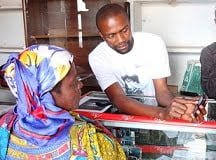Partnering for success: What works in e-cash programs?

As the CALP Network readers know, cash transfer programming is growing in use in a variety of locations and situations. After years of using cash transfers, humanitarians are increasingly interested in taking advantage of electronic delivery mechanisms to offer program participants additional choice, capture potential security improvements and simplify the administrative burden of voucher programs. Of the increasingly diverse range of delivery mechanisms, electronic cash (or e-cash) offers increased potential for links to additional financial services and flexible spending, but has unique use challenges in humanitarian programs.
The Electronic Cash Transfer Learning Action Network (ELAN) defines electronic cash as a substitute for cash that provides full flexibility for purchases that may be stored, spent, and/or received through a mobile phone, prepaid debit/ATM card or other electronic transfer. Recent humanitarian uses of e-cash have often proven challenging. While a few international companies provide e-voucher solutions, e-cash is offered either by entities (such as banks and mobile network operators) in a program country or by third party companies offering remotely loadable debit cards. Either e-cash provider requires an arrangement to make cash available to program participants through ATMs, banks, agent networks or vendors who accept their payments.
Background: Collecting learning from e-cash program experiences

Based on several organizations’ published challenges related to delivering e-cash, the ELAN wanted to determine what lessons from e-cash programs applied across contexts and how these lessons could guide partnership development and planning with financial service providers. In addition, we wanted to highlight some recent tools that can be used for e-cash planning and use. A full version of the study is available here, but some of the highlights from the interviews are listed below.
Key findings from the study include:
- Service quality ranged significantly depending on program location. Unsurprisingly, rural areas were harder to reach with e-cash (and services available were of lower quality) than in urban areas. Humanitarian organizations reported relatively smooth service from remotely loadable card providers, but since only one percent of participants in the surveyed programs could access ATMs (and almost exclusively in urban areas), increasing card use will not solve many of our program challenges. To tackle this challenge, the ELAN will bring together humanitarian agencies and e-cash providers in West and Central Africa early 2016. Together, we will identify opportunities to improve working together, improve agent or digital payment networks in rural areas and get better at identifying when e-cash networks simply aren’t ready to offer quality e-cash services for high volume programs.
- Although a few organizations had pre-positioned contracts prior to emergencies, these contracts did not yield favorable terms with providers. Written service-level agreements (SLAs) were a better tool for guaranteeing service quality. Treating SLAs as an annex to a contract to help legal teams to review them separately may speed the contracting process. This finding could influence humanitarian agencies’ preparedness work. In 2016, the ELAN plans to produce and share draft SLAs as a tool for the humanitarian community.
- In the reviewed programs, humanitarian agencies needed relationships with both central offices (for account creation and contracting) and field-level agents in order to ensure service quality. Especially when humanitarian programs generate significant increases in demand for rural cash-out services, agents need to carefully plan to meet this increased demand. This is an area where further discussion with e-cash providers could help us understand the costs and challenges from a business perspective and how we could jointly overcome these to strengthen programs.
- The review found that strong communication was essential for finding creative solutions – like temporarily expanding agent networks or deploying mobile ATMs to address immediate cash out needs, or customizing products. Where communications were challenging, different understandings of terminology led to significant delays for program participants. Implementers should also be cautious when considering products and services that will require significant customization in an emergency response as providers and humanitarian agencies have repeatedly underestimated the time and work required to make these adjustments.
- Several programs overcame technology barriers, even among vulnerable populations, with participants successfully learning to use new technologies that allowed them to access assistance. Training was required for new users of ATMs and mobile banking in Jordan and the Philippines, but requests for help significantly declined after the first use. Though access challenges seem to be surmountable in most contexts, it is still important to match products and services with our participant’s needs. For example, we should choose even distribution amounts that match standard ATMs withdrawal amounts (20, 50, 100, etc.) in order to reduce fees and the risk of unclaimed aid.
Next steps:
To build on this research, the ELAN is currently engaging e-cash providers, especially Mobile Network Operators that currently partner with humanitarians, to learn more about their experiences and business requirements. Next, we plan to bring together humanitarian and financial service provider representatives to explore the conditions and contexts that are best suited to e-cash and think about how humanitarians can be better e-cash customers. Stay tuned for updates on the CALP Network site join the ELAN mailing list here.
This article was written by Lili Frey, Electronic Cash Transfers Officer at Mercy Corps. If you have questions, suggestions or want to get involved, please contact Lily Frey at lfrey@mercycorps.org.


